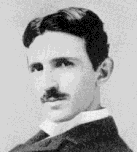Supercomputers
With the invention of
the transistor in 1948, computers became smaller and faster during
the late 1950s and throughout the 1960s.
The development of integrated
circuits at large scale (LSI), then very large scale (VLSI) and
ultra-large scale (ULSI) helped diminish the size and price of
computers which have now almost become a household item.
With the spread of computers in the late 1950s, people started
to think about connecting them via the existing phone lines.
One problem arose: How to translate the binary signals coming
out of computers into sounds that are transmissible across telephone
line.
The
Modem:
AT&T found the
answer in 1957 and invented the modulator-demodulator better known
under the name of modem.
A modem can send data to another computer over the telephone network,
by converting a digital signal (from the computer) to an analogue
audio signal.
The modem of the host computer receives the analogue signals and
converts them back to digital signals for the host computer to
use.
Modems are "low cost" solutions for basic communications
such as electronic mail (e-mail), file transfer, Internet access.
Digital
Networks:
The alternative
to the use of a modem is to belong to a digital network.
The Integrated Services Digital Network (ISDN) is a new communications
architecture that integrates voice, data and video transmission
simultaneously over a single access line. ISDN is fast, reliable
but it is expensive.
Some of the major studios in the world have ISDN links so that
musicians do not have to be in the same country let alone the
same studio to record onto the same multi track recorder or to
do overdubs.
The Scottish musician
Jesse Rae completed the first album using only ISDN to record
the various tracks in 1995.
The album was called 'Compression'
Repise
of the origin of the Internet:
The Internet started
in the late 1960s as a project of the U.S. Department of Defence:
the military wanted a communication network that would function
even if parts of it were broken, things that usually happen during
wartime!
To complicate things
further,
the military had many computers from different manufacturers which
were incompatible (sounds familiar?). This network had to work
between machines of different type.
In October 1969,
two computers talked to each across a telephone line: this network
was named ARPAnet.
As time passed, ARPAnet grew and connected many more computers
between each other.
Internet
Protocols:
A new tool called
Internet Protocol or IP was created in order to get different
computers to communicate through a network.
An Internet Protocol is a set of "laws" that all computers
on a network have to follow.
Among the internet protocols that are still in use today:
telnet: remote connection (login)
to a machine.
ftp (file transfer protocol): file
transfer between computers.
E-mail: electronic mail.
Network:
Computers communicate
by sending packets over the network which makes sure that the
packets arrive at destination; the route that the packets follow
is not important.
A good analogy to the
Internet is the Postal Service:
The IP is equivalent to putting a stamp on a letter: no matter
which country you are in, you need a stamp to send a letter.
The Internet is like the Postal Service: once you send the letter,
it will redirect the letter until it arrives to its destination,
using whatever route is available.
THE
INTERNET:
By the 1980s, the Internet gained popularity among research organisations
and universities which started to use it in order to exchange
information and data.
The World Wide Web or
WWW was created at CERN, a physics laboratory in Geneva, Switzerland.
It was used as a tool to exchange and modify documents between
scientists and other organisations.
HTTP:
A new protocol called
Hyper Text Transmission Protocol or HTTP, was created: it allowed
the transmission of "web pages" over the Internet.
The pages could contain text, graphics, music, and animations.
They linked to other pages by hypertext links.
If you check the location
entry box on your web browser, you will notice that it is most
likely starting with:
http://......
We have come a long
way since May 24th, 1844 when Samuel Morse sent the first telegraph
message between Washington D.C. and Baltimore.
However, the communications
revolution did not happen overnight! It relied and is still relying
on basic research!
What would have happened
if the work of Maxwell on electromagnetism had been done in the
18th-century? We might have had television sets in the 19th-century!
Throughout
these pages of the concise history of the communications revolution
one name has not been mentioned.
This is not something
I have intentionally done. If you delve into the history of electronics
via the myriad of books that are available and even if you check
out some of the world's greatest scientific resources (including
The Smithsonian), you will find
that the name of one of the world's greatest geniuses is not even
mentioned. His discoveries and inventions are not accredited to
him and are passed off as the work of others. Edison being a prime
recipient of misplaced credit.
 The
great man's name is NIKOLA TESLA without who, most of the preceding
would not have been possible.
The
great man's name is NIKOLA TESLA without who, most of the preceding
would not have been possible.
If you have never heard of Mr Tesla I am not surprised.
But if you are like me and are seeking the truth, then I advise
you to enter his name into any search engine and have a read about
the man and his history.
Some of it is highly strange………………..!
EACH ONE, TEACH
ONE.
Home / The Spider
ALL
IMAGES AND TEXT COPYRIGHT © Falasha recordings
 The
great man's name is NIKOLA TESLA without who, most of the preceding
would not have been possible.
The
great man's name is NIKOLA TESLA without who, most of the preceding
would not have been possible.